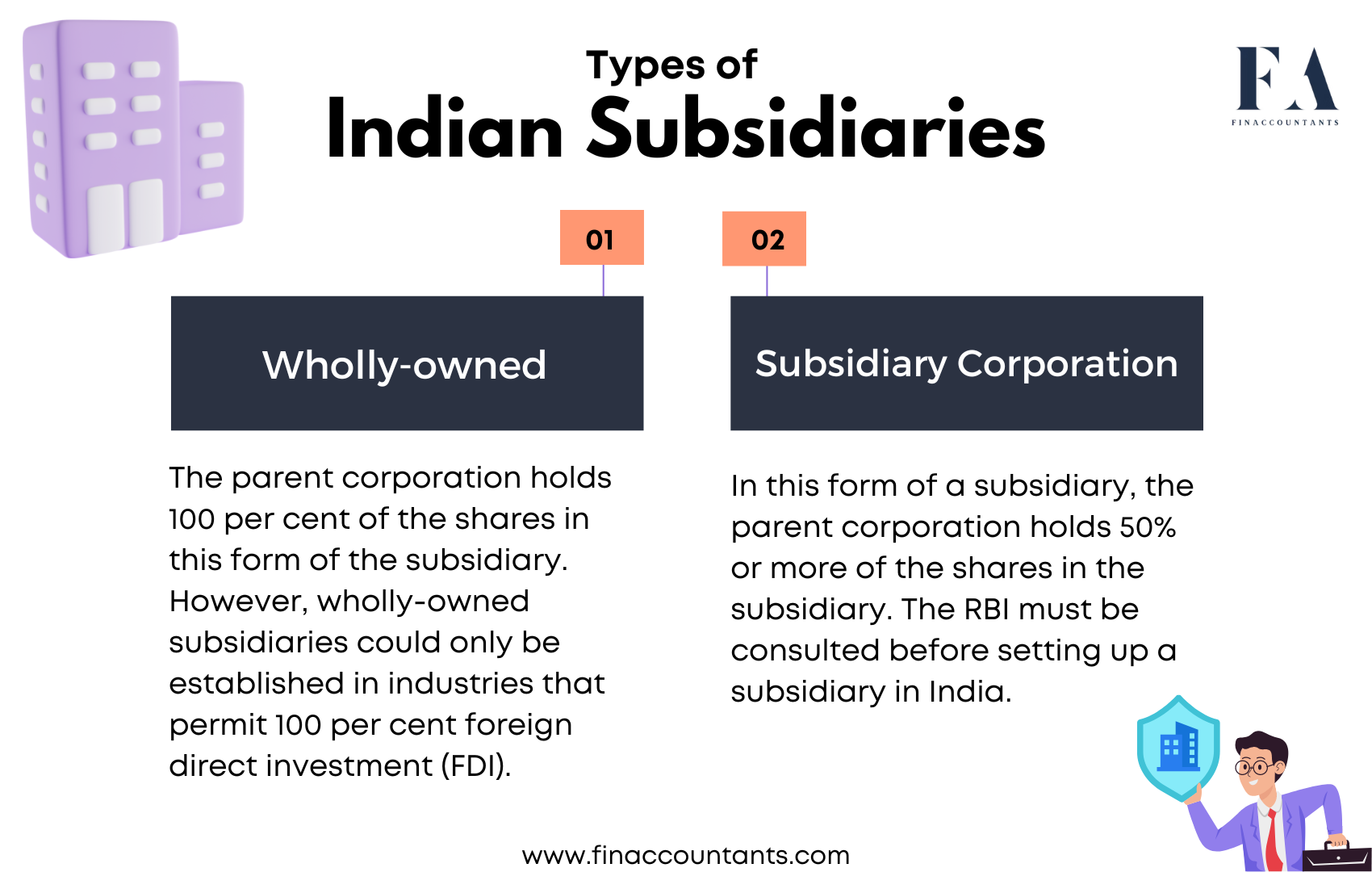India is quickly becoming one of the most appealing business destinations in the world. Pro-business policies, capital investments, and welcoming foreign companies to join forces on domestic projects are just a few of the steps that India is taking to position itself as a business-friendly nation.
Setting up a subsidiary in India is challenging, and your business must find the resources—both time and money—to grow while becoming familiar with all applicable Indian laws. Another layer of complexity is added by the fact that state and regional laws and regulations differ.
Furthermore, Indian rules and regulations permit foreign corporations to establish subsidiaries in the country and gain numerous benefits. By utilizing India’s large market size and huge skill set, businesses can open various subsidiaries and establish lucrative businesses.
Basics of Subsidiary Company & How to Set Up a Subsidiary Company in India?
An organization owned entirely or partially by another company is referred to as a subsidiary company, and this organization that has additional operations is termed a holding company or parent company. There are various reasons why you might want to establish a subsidiary company, including business diversification, lowering your financial obligation, and maintaining the distinctiveness of your company’s brands.
In India, there are 2 types of subsidiaries.

1. Wholly-owned
The parent corporation holds 100% of the shares in this form of the subsidiary. However, wholly-owned subsidiaries could only be established in industries that permit 100 percent foreign direct investment (FDI).
2. Subsidiary corporation
In this form of a subsidiary, the parent corporation holds 50% or more of the shares in the subsidiary. The RBI must be consulted before setting up a subsidiary in India.
How does a subsidiary business operate?
Even though normally, the parent company is likely to have a significant amount of impact on the subsidiary company or organization, including seats on the board, subsidiaries are distinguishable from their parent companies. However, if the subsidiary is based in a different nation than the parent company, it will be required to comply with the laws and regulations of that nation. Subsidiary companies may also have separate debts, securities, and governance practices.
Documents Required for Incorporation

- Workplace Address Proof (Water Bill or Housing Contract) and the most recent self-attested electricity bill in the case of rented properties.
- Indian citizens: Pan card, identity card, as well as updated self-attested power bills in the case of rental firms, and photo ID proof, are required.
- International Citizens: Passport (required), Identity card ( most recent bank statement or passbook, or lease contract in the case of rented properties, and most recent electricity bill). The Indian embassy must acknowledge the documents.
- Photo ID Proof: Any government license or document that clearly shows the applicant’s full name, a picture with a clear resolution, and the birth date.
The following are the minimum requirements for incorporating an Indian subsidiary company:
- At least two directors must be listed.
- There are two stockholders needed.
Set-Up Procedure of a Subsidiary Company in India
The owners have the right to start the incorporation process once the minimum requirements ( previously described) have been satisfactorily met.
- The first steps in the incorporation process for a subsidiary company include the application for a minimum of two DSCs (Digital Signature Certificates) and the requirement that all directors obtain a DIN (Director’s Identification Number).
- After completing the pre-mentioned steps, the applicant must submit Form INC-1, per the name application process, to request the company name. However, remember that the name you apply for must differ from other business names.
- An applicant must submit Form INC-7 or an application (for the registration of a company apart from a one-person company) after the ROC has approved the name.
- An applicant must submit Form INC-7 or an application for incorporating a company other than a one-person company after the name has been approved by the ROC (Registrar of Companies) of the Ministry of Corporate Affairs. Details of the appointment of new directors and managing directors are contained in Form DIR-12. Number INC-22 refers to the company’s MOA and the situation-specific notice clause.
- The applicant must then file the company’s registration documents, pay the Registrar of Companies’ online fees, and pay any applicable stamp duty.
- ROC verifies all filed documents uploaded in the application after the relevant determined fees have been paid. The forms INC-22 and DIR-12 mentioned above are approved using the Straight-Through-Process (STP), and after that, the ROC confirms Form INC-7, which is an application for the incorporation of companies, in detail. Where necessary, the ROC may suggest modifying the pattern or an attachment.
- The Certificate of Incorporation is finally sent out to the applicant via email in a detailed format after the changes have taken effect and the ROC is satisfied with the complete application and document requirements.
- If the applicant follows the proper procedure and the documentation mentioned above is available, there won’t be any needless delays from the ROC, and the company can be successfully incorporated.
Laws for Subsidiary Company in India.
In India, subsidiaries are legally distinct from the parent corporation and must abide by all applicable regulations.
Companies must choose one of the following business types when establishing a subsidiary in India:
1. Limited liability (Pvt. Limited) Company
The best organization for small and midsize enterprises is this one. They are the most well-liked in India and have the fewest reporting obligations. There must be a minimum of 2 subscribers and with no paid-up capital requirements of $1,620 in paid-up capital according to Indian subsidiary laws. Private corporations must have a minimum of 2 directors and a maximum of fifteen. Within six months of the fiscal year’s end, you should prepare financial statements and reports and submit them for audit.
2. Public limited liability company
This public company’s subsidiary is subject to SEBI(Securities and Exchange Board) rules. Subsidiary regulations in India state that you must have a minimum paid-up capital of $8,100 and a minimum of seven subscriptions. Additionally, public companies must have at least 3 directors and a maximum of fifteen. The same accounting and auditing standards apply to both public and private subsidiaries.
Benefits of Setting Up an India Subsidiary

There are many benefits to creating an Indian subsidiary company, but the following benefits will apply in the particular instance of the Indian subsidiary.
1. Separate judiciary structure
The Indian subsidiary is governed by Indian commercial law and has a separate or independent legislative framework from its parent company.
2. Share transfers
After approving a transfer of securities form and a share certificate, a stockholder may easily exchange or transfer the shares they bought to another party or individual.
3. Purchase of real estate in India
Because the subsidiary is a separate legal entity, it is permissible to purchase real estate in India.
4. FDI incorporation
As was already mentioned, the majority of the economic activities in that nation are open to foreign direct investment by Indian subsidiary companies.
Take Away
The rules that determine an Indian company apply to being a subsidiary company in India in the same way that they do to other types of Indian companies. The applicant company will receive the Certificate of Incorporation as soon as possible if it follows the above-said incorporation procedure and provides the required documentation.




Leave a Reply